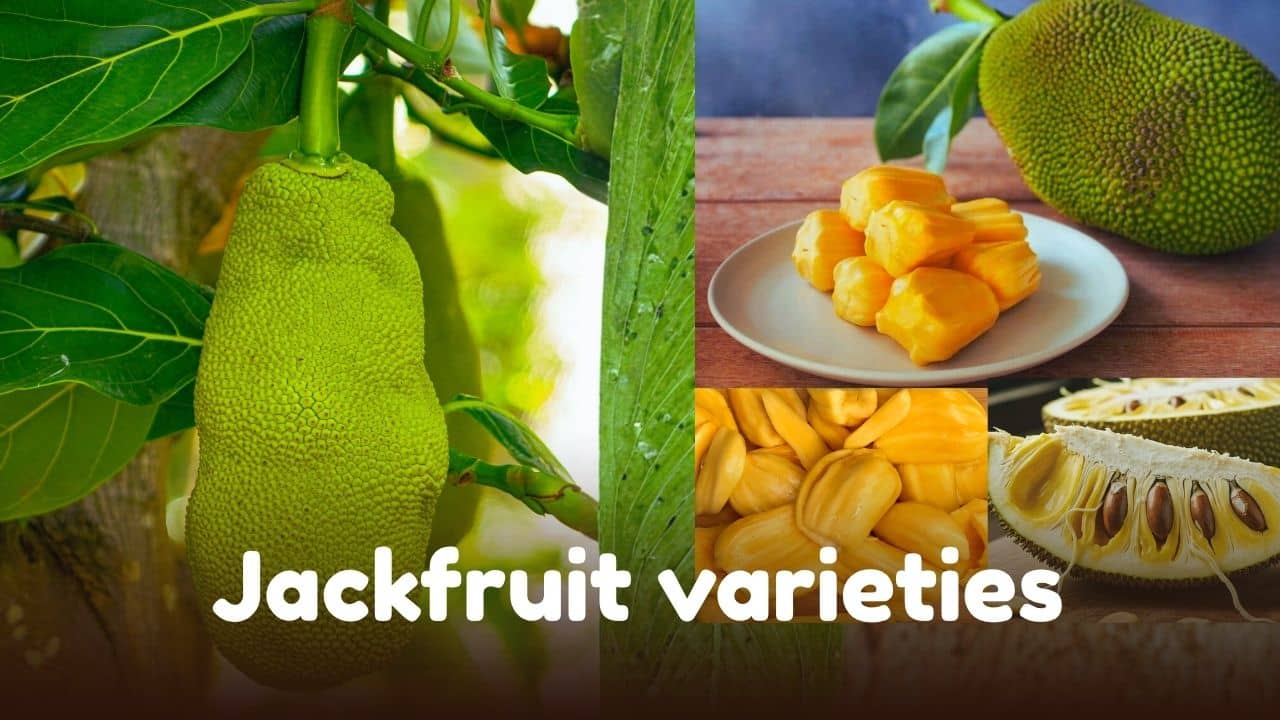If you’ve ever walked past a spiky green giant at your local market and wondered, “What on earth is that?” — meet the jackfruit, the world’s largest tree-borne fruit and one of the most fascinating tropical plants on the planet.
In recent years, jackfruit has gone from a regional delicacy in South and Southeast Asia to a trending food and gardening sensation in the United States. From vegan BBQ sandwiches to tropical smoothies, jackfruit is showing up everywhere — and for good reason.
Understanding the different jackfruit varieties can enhance your culinary experiences and gardening success.
Table of Contents
In this tutorial, we will explore the various jackfruit varieties to help you choose the best types for your needs.
🍈 What Makes Jackfruit So Special?
The jackfruit tree (Artocarpus heterophyllus) is one of nature’s most remarkable tropical evergreens — known for producing the largest fruit that grows on a tree. Native to the rainforests of India and Bangladesh, it has since spread across Southeast Asia, Africa, the Caribbean, and tropical regions of the United States, including Florida, Hawaii, and Southern California.
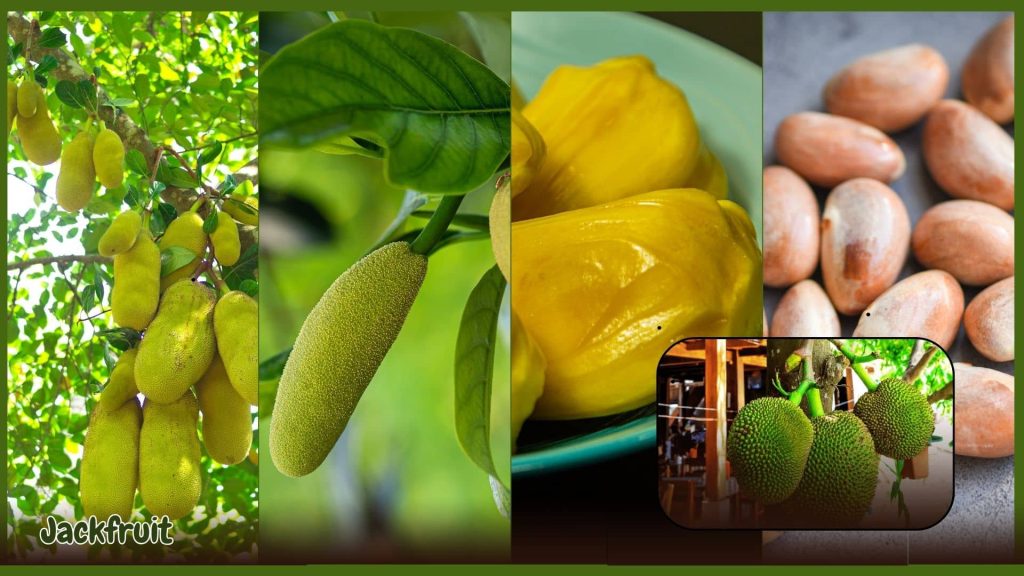
Towering between 30 and 70 feet tall, the jackfruit tree is admired not only for its impressive size but also for its longevity, resilience, and productivity. Its wide canopy of glossy green leaves offers natural shade, while its sturdy trunk bears enormous green fruits that can weigh anywhere from 10 to 80 pounds — sometimes even more.
The jackfruit tree thrives in warm, humid climates, preferring full sunlight and well-drained, fertile soil. It begins producing fruit within 3 to 4 years when propagated from grafted saplings, rewarding growers with an abundance of food for decades
Here’s why people love jackfruit:
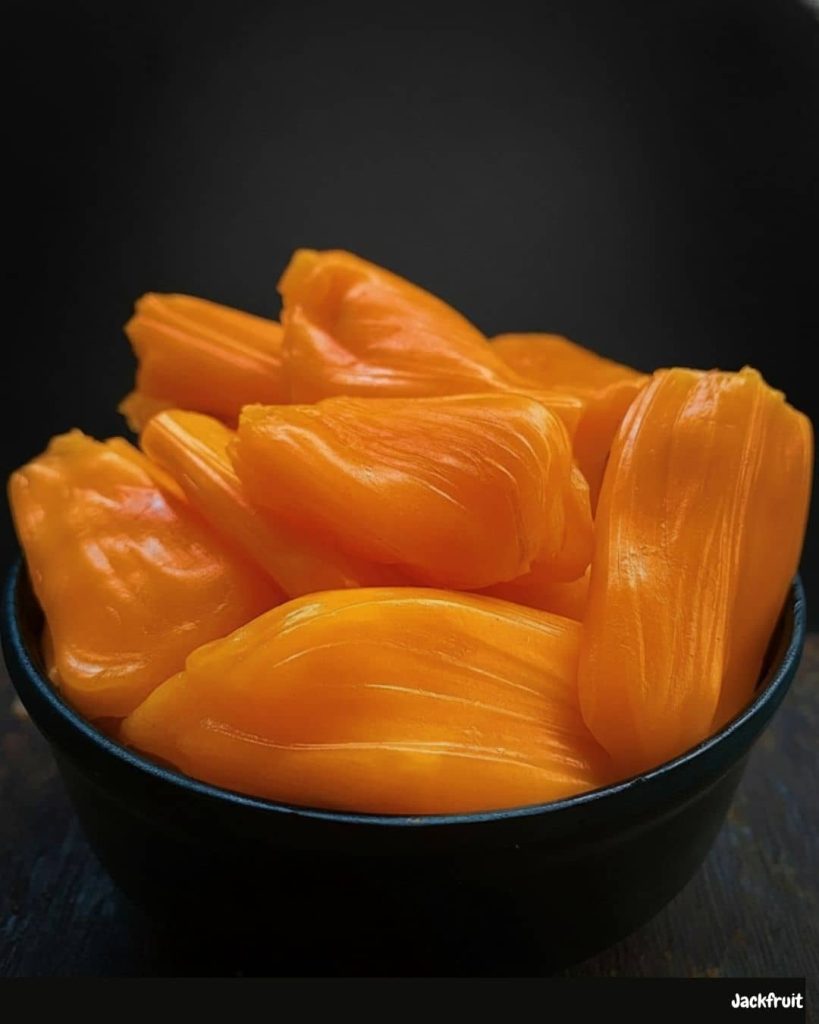
- It’s incredibly versatile. Unripe jackfruit has a neutral flavor and meat-like texture, making it perfect for plant-based dishes. When ripe, it’s sweet and fragrant — great for desserts and snacks.
- It’s packed with nutrients. A natural source of vitamin C, potassium, and fiber, jackfruit supports immunity and digestion.
- It’s sustainable. A single tree can yield hundreds of pounds of fruit per year, making it an eco-friendly food source.
💡 Fun Fact: Jackfruit is sometimes called a “miracle crop” because it thrives in hot, humid climates and can withstand drought — ideal for tropical and subtropical gardens.
USDA National Agricultural Library – Jackfruit Overview
Comprehensive government resource on jackfruit’s agricultural background and global uses.
📘 Jackfruit Varieties Tutorial — Understanding the Basics
Like apples or mangoes, jackfruit comes in many varieties, each with its own characteristics.
Most varieties fall into two main categories:
- Firm-Flesh (Crispy) Varieties
- These have thick, crunchy bulbs and are less sticky.
- Perfect for cooking and easier to handle.
- Examples: Honey Gold, NS1.
- Soft-Flesh Varieties
- These are juicy, rich, and melt-in-your-mouth sweet.
- Excellent for eating fresh or adding to desserts.
- Examples: Black Gold, Cheena.
Then there are hybrid varieties — crossbred for improved texture, yield, and disease resistance. They combine the best of both worlds: sweetness and durability.
🌴 Top Jackfruit Varieties You Should Know
Here are some of the most well-known and loved jackfruit varieties — perfect for both gardeners and tropical fruit lovers in the United States.
🟡 1. Black Gold Jackfruit
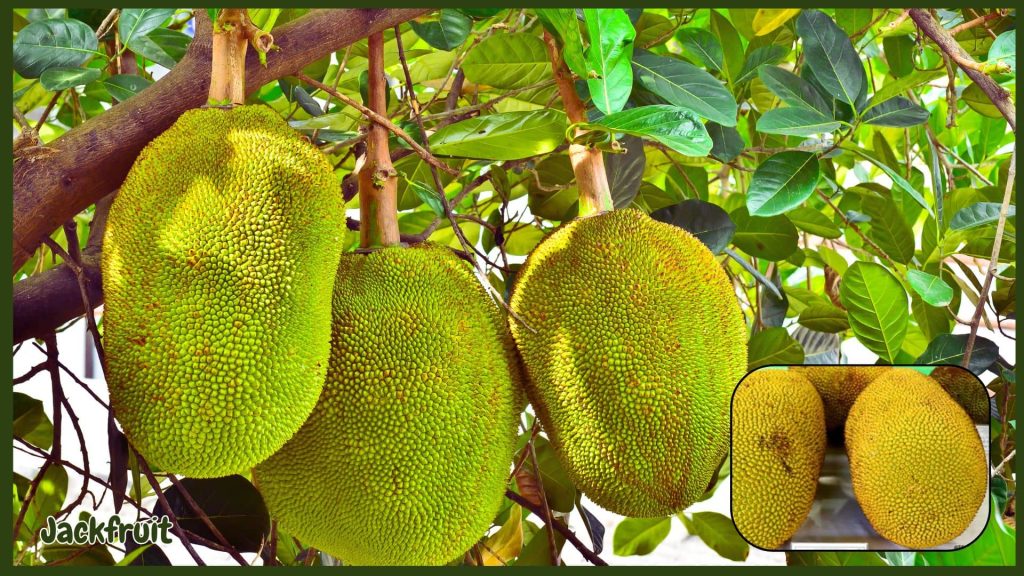
Origin: Australia
Texture: Soft-flesh
Flavor: Sweet, aromatic, with banana-like undertones
The Black Gold variety is a household favorite for growers and consumers alike. It produces medium to large fruits with deep yellow bulbs that are tender and fragrant.
This variety adapts well to the subtropical climates of Florida and Southern California, making it an ideal pick for U.S. gardeners.
💡 Best For: Eating fresh, blending into smoothies, or freezing for desserts.
💡 Growing Tip: It’s a vigorous grower and does well in full sun and well-drained soil.
🟠 2. Honey Gold Jackfruit
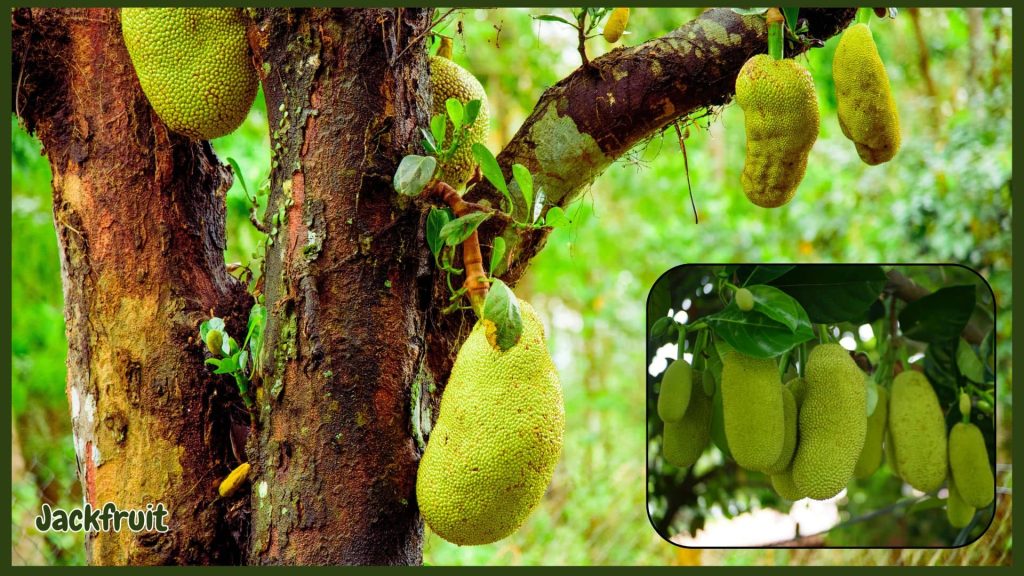
Origin: Thailand
Texture: Firm and crisp
Flavor: Sweet, honey-like taste with a delicate aroma
As the name suggests, this jackfruit variety is known for its honey-sweet flavor and firm texture. The bulbs hold up well during cooking, making it the go-to variety for savory recipes.
💡 Best For: Vegan pulled “pork,” curries, and jackfruit stir-fries.
💡 Pro Tip: Harvest when the skin turns slightly yellow and gives off a sweet fragrance.
🟢 3. NS1 (Ng Sue Lim) Variety
Origin: Malaysia
Texture: Medium-firm
Flavor: Balanced sweetness with a subtle caramel aroma
The NS1 variety is an excellent early bearer — meaning you won’t have to wait years for your first harvest. It produces smaller, easy-to-handle fruits and performs well in home gardens.
💡 Best For: Beginner gardeners or small farms.
💡 Growing Note: Requires regular watering during dry spells for optimal yield.
🟣 4. Golden Nugget Jackfruit
Origin: Australia
Texture: Medium-firm
Flavor: Lightly sweet with a pleasant fruity fragrance
Compact and manageable, Golden Nugget is one of the best varieties for gardeners with limited space. The fruits are smaller (around 10–15 pounds) but packed with flavor.
💡 Best For: Container growing or small backyards.
💡 Fun Fact: Golden Nugget trees often fruit earlier than other varieties.
🟤 5. Cheena (Jackfruit × Chempedak Hybrid)
Origin: Malaysia (hybrid cross between jackfruit and chempedak)
Texture: Soft, tender, and aromatic
Flavor: Intensely sweet and complex, with tropical notes
Cheena is loved by chefs and fruit enthusiasts for its smooth, less fibrous texture and bold flavor. It’s often used in gourmet desserts or enjoyed fresh.
💡 Best For: Baking, fruit salads, and exotic desserts.
💡 Tip: Harvest at full ripeness to enjoy its signature tropical fragrance.
🌿 How to Grow and Care for Jackfruit Varieties
Growing jackfruit may sound exotic, but it’s surprisingly achievable for many gardeners in the southern United States.
🌤️ Climate and Location
- Ideal for USDA zones 9–11.
- Loves warm temperatures (75–95°F) and high humidity.
- Prefers full sunlight — at least 6–8 hours daily.
🌱 Soil and Fertilization
- Use well-draining loamy soil enriched with compost.
- Maintain soil pH between 6.0 and 7.5.
- Fertilize every 2–3 months with a balanced mix (e.g., 10-10-10 NPK).
💧 Watering
- Water regularly, especially in dry or windy weather.
- Avoid overwatering — soggy soil can lead to root rot.
- Mulch around the base to retain moisture and suppress weeds.
✂️ Pruning and Maintenance
- Prune young trees to shape and promote airflow.
- Remove any diseased or crossing branches.
- Expect fruit in 3–4 years from planting.
💡 Gardening Tip: In cooler regions, consider growing jackfruit in large containers so you can move them indoors during winter.
Growing jackfruit successfully depends on sunlight, soil quality, and moisture balance. For region-specific advice, you can refer to the University of Florida IFAS Extension guide on jackfruit cultivation, which provides detailed insights for U.S. growers.
🍴 How to Choose the Right Jackfruit Variety
When deciding which variety to grow or buy, consider your goals:
| Goal | Best Varieties |
|---|---|
| Fresh eating | Black Gold, Cheena |
| Cooking & savory dishes | Honey Gold, NS1 |
| Small gardens or pots | Golden Nugget |
| Complex gourmet flavor | Cheena |
When buying from a market:
- Look for fruits that have a pleasant aroma (a sign of ripeness).
- The skin should be yellow-green and slightly soft to the touch.
- Avoid fruits with cracks, dark spots, or oozing sap.
💡 Storage Tip: Wrap cut jackfruit tightly and refrigerate for up to a week — or freeze the bulbs for smoothies and desserts.
🍛 Creative Ways to Enjoy Jackfruit
Jackfruit’s culinary potential is huge — it can star in both savory and sweet dishes.
🍔 For Savory Lovers
- Pulled Jackfruit Sandwiches: Simmer unripe jackfruit (like Honey Gold) in BBQ sauce for a tender, smoky filling.
- Jackfruit Curry: Combine cubes of young jackfruit with coconut milk, turmeric, and spices.
- Tacos: Shredded jackfruit works beautifully with avocado, salsa, and lime.
🍨 For Sweet Tooths
- Jackfruit Smoothies: Blend ripe Black Gold jackfruit with banana and coconut water.
- Desserts: Cheena pulp makes delicious fillings for cakes and pastries.
- Frozen Treats: Puree ripe bulbs and freeze into tropical popsicles.
💡 Cooking Tip: Always oil your knife when cutting jackfruit — its natural latex sap can be sticky!.
🍽️ Storage and Preparation Tips
Jackfruit can be intimidating at first, but it’s not as complicated as it looks! Here’s how to make it easier:
- Oil your knife and hands before cutting to prevent the sticky latex from clinging.
- Remove the core first, then separate the bulbs from the fibrous strands.
- Store fresh bulbs in an airtight container in the fridge for up to 5 days.
- Freeze ripe jackfruit for smoothies or desserts — it tastes like tropical candy when thawed.
- For cooking, rinse canned jackfruit well to remove brine before seasoning.
Quick Recipe Ideas:
- Pulled jackfruit BBQ sandwich
- Thai jackfruit curry
- Jackfruit mango smoothie
- Jackfruit chips or fritters
Check out more Jackfruit recipes in this article!.
🌻 Conclusion
Congratulations — you’ve completed your jackfruit varieties tutorial! 🌴
By now, you know that jackfruit isn’t just one fruit — it’s a whole world of varieties, each with unique flavors and characteristics. Whether you’re planting a Golden Nugget tree in your backyard, cooking Honey Gold jackfruit tacos, or savoring a Cheena dessert, this tropical fruit offers endless ways to enjoy and experiment.
Is jackfruit related to durian?
👉 No, jackfruit and durian are not closely related.
Jackfruit belongs to the Moraceae (mulberry) family, while durian is part of the Malvaceae family. They look similar on the outside but differ in flavor, smell, and botanical classification.
Which jackfruit variety is best for cooking?
👉 The Honey Gold variety is best for cooking.
It has a firm texture that holds up well in heat, making it ideal for curries, stir-fries, and vegan pulled “pork” dishes.
Which jackfruit variety is the sweetest?
👉 The Cheena variety is considered the sweetest.
It’s a hybrid of jackfruit and chempedak, known for its rich aroma, soft flesh, and intense tropical sweetness.


